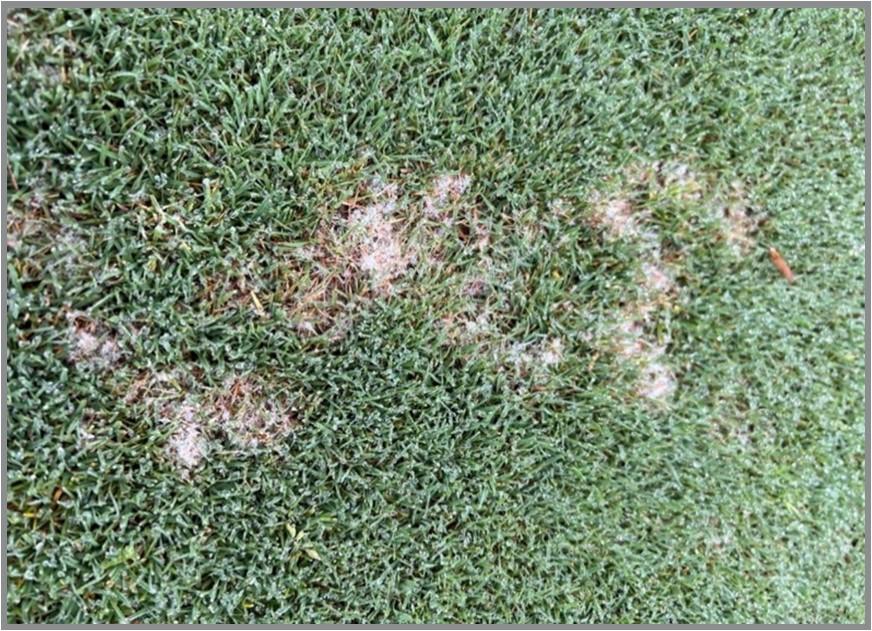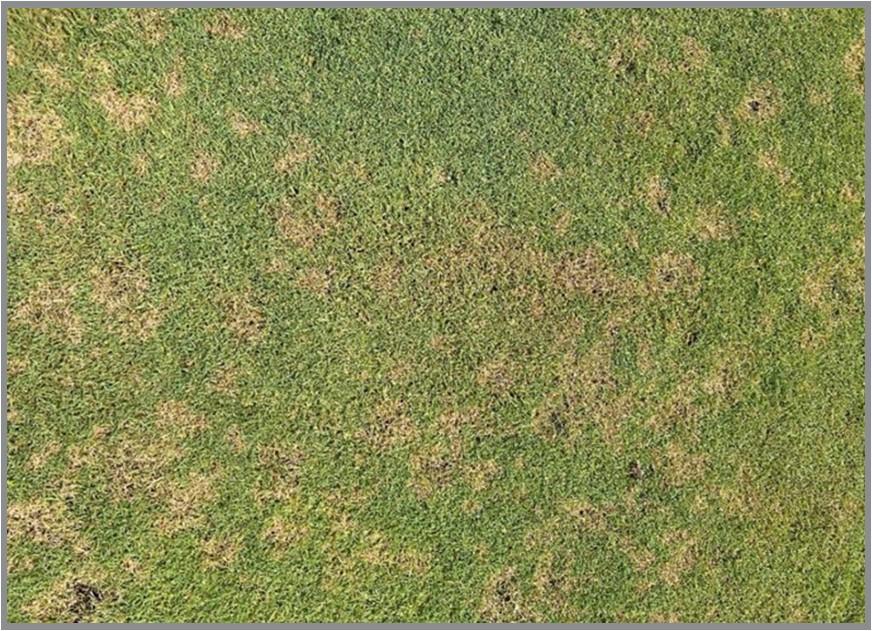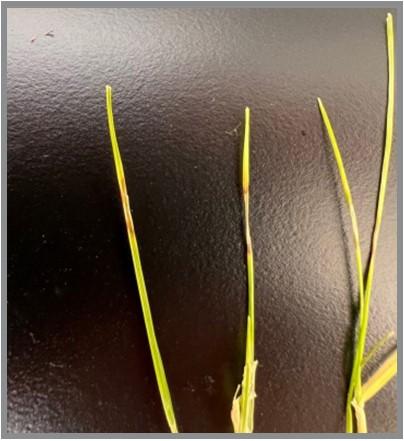
FS-2023-0665 | July 2023
Turfgrass Diseases: Dollar Spot

Dollar spot is a common fungal disease that affects turfgrass and is capable of causing damage to golf courses, athletic fields, and home lawns; however, it is more of a concern on high-maintenance turfgrass such as golf courses. Dollar spot can affect a wide range of turfgrass species, but some are more susceptible than others. Specific cultivars of creeping bentgrass and annual bluegrass are highly susceptible to dollar spot, while tall fescues, perennial ryegrasses, and Kentucky bluegrasses are moderately susceptible. Zoysiagrass and bermudagrass are less susceptible to dollar spot than the other species. Less susceptible species can be significantly damaged under environmental conditions that encourage the growth and spread of the fungus.
Causal Agent
Dollar spot disease is caused by several species of a fungal pathogen (Clarireedia spp.) with C. jacksonii and C. monteithiana being the most common species on cool season and warm season turfgrass in the US, respectively. Clarireedia spp. infection occurs through penetration of the mycelium (a network of thread-like structures) to the leaf tissue. The pathogen survives unfavorable environments such as winters by forming dark-colored survival structures known as stroma.
Signs and Symptoms


The pathogen produces mycelium that grows on the turfgrass leaves, stems, and thatch which is visible on the canopy after prolonged leaf wetness durations (Figure 1). Initial symptoms of the disease under golf course management are the formation of 1-3-inch discolored spots, approximately the size of a silver dollar. The spots are usually circular or oblong in shape and have a brownish-tan color (Figure 2). On higher-cut (2-3 inches high) turfgrass, such as athletic fields or home lawns, the infected areas can expand to 6 inches or more, and the grass blades will have tan lesions with brown borders. These lesions resemble hourglass shapes which make dollar spot lesions distinguishable from other diseases such as brown patch and Pythium blight (Figure 3). As the disease progresses, the patches merge to form larger areas of damage. The affected turfgrass may appear thin and stunted, and the leaves may turn yellow and wither. In severe cases, the turfgrass may die and eventually leave bare soil behind.
Favorable Environment
The pathogen is most active when the temperatures are between 60°F and 85°F (15°C and 30°C) and the relative humidity is high (above 90%). However, some other diseases such as brown patch, gray leaf spot, or Pythium are more severe in mid-summer when the temperature is higher. In Maryland, dollar spot occurs between late March/early April to October with the disease being most prevalent in the spring and fall. It is worth noting that under favorable environmental conditions, the disease may appear 12 months out of the year in Maryland. Warm days and cool nights that result in dew formation on the turfgrass canopy provide the most favorable environments for dollar spot outbreaks.
Disease Management
Resistant Cultivars
New turfgrass cultivars have better dollar spot tolerance levels. For instance, creeping bentgrass cultivars Oakley, Coho, Declaration, Piper, and 007XL have shown promising dollar spot tolerance. More information about improved cultivars is available on the National Turfgrass Evaluation Program (NTEP) website at www.ntep.org.
Cultural Management
Cultural practices are an important component of an integrated pest management program for dollar spot disease. The following cultural practices can help prevent or reduce the severity of the disease:
- Proper Irrigation: Proper irrigation is critical for preventing dollar spot disease. Irrigation should be timed to avoid prolonged periods of leaf wetness, which promote the growth of the pathogen. Early morning irrigation is preferable to evening irrigation because it allows the turfgrass to dry out during the day.
- Fertility Management: Proper fertility can help prevent dollar spot disease by promoting healthy turfgrass growth. Turfgrass should be fertilized according to soil test results to ensure the appropriate amounts of phosphorus and potassium. Applying nitrogen fertilizer in late spring/early summer reduces the dollar spot severity. Nitrogen applications in multiple, small applications has better results in disease management rather than single, high rates. This will promote steady growth and reduce the risk of dollar spot outbreaks. Please refer to Maryland nutrient management guidelines as outlined in the University of Maryland Turfgrass Technical Updates for more information.
- Mowing Practices: Proper mowing can help prevent dollar spot disease by promoting healthy turfgrass growth. Turfgrass should be mowed at the appropriate height for the species and maintained at a consistent height. Mowers with sharp blades will reduce the tearing of the turfgrass blades, thereby promoting healthy growth.
- Rolling, Topdressing, and Dew Removal: Researchers at Michigan State University note that daily lightweight rolling (4 to 5 times per week) can significantly reduce the severity of dollar spot on putting greens. An additional research study revealed that sand topdressing was more consistent at reducing dollar spot in golf course fairways compared to rolling. Regular dew removal can also reduce the disease severity which will allow extended fungicide application intervals. It is important to note that other factors such as weather conditions and fungicide efficacy can change the impact of these cultural practices.
- Thatch Management: Extensive thatch accumulation, which adversely affects air exchange, water infiltration and fertilizer utilization, can create an environment conducive to dollar spot disease development. Thatch should be managed through core aeration and topdressing to encourage the breakdown of thatch and promote healthy soil structure.
- Soil Management: Relieving soil compaction is critical for preventing dollar spot disease. Soil compaction should be reduced through core aeration, and drainage should be improved in areas where water tends to accumulate.
Biological Management
Several species of Bacillus and Trichoderma can be effective in dollar spot management (Clarke et al., 2021). Bacillus licheniformis (product name: EcoGuard) has a more consistent dollar spot control than other biological agents such as Bacillus subtilis strain QST 713 (Rhapsody), Trichoderma harzianum Rifai strain T-22 (T-22 WP), and Trichoderma virens G14 (TurfShield PLUS). There are limited experiments conducted on Pseudomonas species. It is important to notice that biological materials are not effective for dollar spot management as a stand-alone management technique. However, incorporating biological control with other management practices such as cultural and chemical is beneficial and could reduce the number of chemical applications.
Chemical Management
Fungicides are one of the primary means for managing dollar spot management, especially on golf courses and athletic fields. It is important to note that fungicides should be used in conjunction with cultural practices and should not be relied upon as the sole means of control. Overuse of fungicides can lead to the development of fungicide-resistant strains of the pathogen, which can be more difficult to control. It is also important to rotate the use of fungicides with different modes of action or to tank mix different groups to reduce the risk of resistance development. This is specifically important for dollar spot, as some isolates of the pathogen have shown resistance to thiophanate methyl. Some isolates also have reduced sensitivity to several sub-groups of SDHI and DMI fungicides, and iprodione. Table 1 outlines the list of some of the fungicides with consistent effective dollar spot control across studies; this list does not include all the commercially available fungicides.
| Fungicide (Brand name) | Efficacy | Interval (days) | Fungicide Resistance Action Committee (FRAC) Code |
|---|---|---|---|
| Myclobutanil (Eagle)¹ | Very Good to Excellent | 14-28 | 3 |
| Penthiopyrad (Velista)¹ | Very Good to Excellent | 14-21 | 7 |
| Pydiflumetofen (Posterity) | Excellent/ Very Good to Excellent² | 14-28 | 7 |
| Pyraclostrobin (Insignia Intrinsic)¹ | Very Good to Excellent | 14 | 11 |
| Tebuconazole (Torque, Mirage Stressgard, Sipcam Clearscape ETQ, Offset, ArmorTech TEB360) | Excellent | 14-28 | 3 |
| Thiophanate-methyl (3336)¹ | Excellent³ | 10-21 | 1 |
| Prothioconazole (Densicor) | Very Good to Excellent | 14-21 | 3 |
| Fluazinam (Secure, Rotator, Soteria) | Excellent | 14 | 29 |
| Fluxapyroxad (Xzemplar)¹ | Excellent³ | 14-28 | 7 |
| Mandestrobin (Pinpoint)¹ | Excellent / Very Good to Excellent² | 14-21 | 11 |
| Mefentrifluconazole (Maxtima) | Excellent | 14-28 | 3 |
| Metconazole (Tourney)¹ | Excellent | 14-21 | 3 |
| Propiconazole (Banner Maxx, Spectator, Savvi)¹ | Excellent | 7-28 | 3 |
| Triticonazole (Trinity, Triton)¹ | Very Good to Excellent³ | 14-28 | 3 |
| Azoxystrobin + chlorothalonil (Renown) |
Very Good to Excellent | 7-14 | 11 + M5 |
| Azoxystrobin + propiconazole (Headway, Goliath)¹ | Very Good to Excellent | 14-28 | 11 + 3 |
| Boscalid + pyraclostrobin (Honor Intrinsic) | Very Good to Excellent | 14-28 | 7 + 11 |
| Chlorothalonil + acibenzolar-S-methyl (Daconil Action) | Very Good to Excellent | 7-21 | M5 + P1 |
| Chlorothalonil + fludioxonil + propiconazole (Instrata) | Excellent | 21-28 | M5 + 12 + 3 |
| Chlorothalonil + iprodione + thiophanatemethyl + tebuconazole (Enclave) | Very Good to Excellent | 14-28 | M5 + 2 + 1 + 3 |
| Chlorothalonil + propiconazole (Concert, Concert II) | Excellent | 14-28 | M5 + 3 |
| Chlorothalonil + thiophanate-methyl (ConSyst, Spectro, Broadcide, Peregrine, Tee-1- Up, TM/C) | Very Good to Excellent | 14-21 | M5 + 1 |
| Fluazinam + acibenzolar-S-methy (Secure Action) | Excellent | 14-21 | 29 + P1 |
| Fluazinam + tebuconazole (Traction) | Excellent | 14 | 29 + 3 |
| Fluopyram + trifloxystrobin (Exteris Stressgard)¹ | Excellent | 7-28 | 7+11 |
| Iprodione + thiophanate-methyl (26/36, Dovetail, Twosome, ArmorTech TMI) | Excellent | 14-21 | 2 + 1 |
| Iprodione + trifloxystrobin (Interface Stressgard) | Excellent | 14-28 | 2 + 11 |
| Isofetamid + tebuconazole (Tekken) | Excellent / Very Good to Excellent² | 14-28 | 7 + 3 |
| Pyraclostrobin + fluxapyroxad (Lexicon Intrinsic)¹ | Very Good to Excellent | 14-28 | 11 + 7 |
| Pyraclostrobin + mefentrifluconazole (Navicon) |
Excellent | 14-28 | 11 + 3 |
| Trifloxystrobin + triadimefon (Armada¹, Tartan) | Very Good to Excellent | 14-28 | 11 + 3 |
Fungicide labels should be checked for the rates, carrier volume, registration for residential turfgrass areas, and other information.
¹One or all commercial products are registered for residential lawns
²Efficacy varies depending on application intervals
³Researchers have reported isolates of the pathogen with reduced sensitivity or resistance to sub-groups of the SDHI and DMI fungicides, thiophanate methyl, and iprodione.
*Some information in this table is adapted from Clarke, B., Vincelli, P., Koch, & P., Munshaw, G. Chemical control of turfgrass diseases in 2020. University of Kentucky, 2021. http://www2.ca.uky.edu/agcomm/pubs/PPA/PPA1/PPA1.pdf
Conclusion
Dollar spot is a fungal disease that poses a significant threat to turfgrass, particularly highly- maintained turfgrass. Dollar spot can be identified by the formation of small, discolored spots on the low mowing heights and larger patches on higher cut turfgrass. The disease is most active when temperatures range between 60°F and 85°F with high humidity. Proper cultural practices such as irrigation, fertility management, mowing, rolling, topdressing, dew removal, thatch and soil management, along with the use of resistant cultivars, can help prevent or reduce the severity of dollar spot. Biological management using certain species of Bacillus and Trichoderma has shown promise but requires more research. Fungicides are the main tool for disease management, especially in golf courses and athletic fields. However, caution should be exercised to avoid overreliance on fungicides and the development of resistant strains. It is important to regularly rotate fungicides with different modes of actions (FRAC groups) to minimize resistance development. An integrated approach that combines cultural, biological, and chemical management strategies is the most effective means of controlling dollar spot and maintaining healthy turfgrass.
For more information
- Clarke, B., Vincelli, P., Koch, & P., Munshaw, G. (2021). Chemical control of turfgrass diseases in 2020. University of Kentucky. http://www2.ca.uky.edu agcomm/pubs/PPA/PPA1/PPA1.pdf
- Delvalle, T. C., Landschoot, P. J., & Kaminski, J. E. (2011). Effects of dew removal and mowing frequency on fungicide performance for dollar spot control. Plant disease, 95(11), 1427–1432.
- Espevig, T., Usoltseva, M., & Norman, K. (2020). Effects of rolling and Nfertilization on dollar spot and Microdochium patch on golf greens in Scandinavia. In Y. Tokarev and V. Glupov (Eds.), BIO Web of Conferences (Vol. 18, p. 00008). EDP Sciences.
- Giordano, P. R., Nikolai, T. A., Hammerschmidt, R. and Vargas Jr, J. M. (2012). Timing and frequency effects of lightweight rolling on dollar spot disease in creeping bentgrass putting greens. Crop Science, 52(3), 1371–1378.
- Green, T. O., Rogers, J. N., Crum, J. R., Vargas, J. M. and Nikolai, T. A. (2019). Effects of rolling and sand topdressing on dollar spot severity in fairway turfgrass. HortTechnology, 29(4), 394–401.

FERESHTEH SHAHOVEISI
fsh@umd.edu
All photos by the author
This publication, Turfgrass Diseases: Dollar Spot (FS-2023- 0665), is a part of a collection produced by the University of Maryland Extension within the College of Agriculture and Natural Resources.
The information presented has met UME peer-review standards, including internal and external technical review. For help accessing this or any UME publication contact: itaccessibility@umd.edu
For more information on this and other topics, visit the University of Maryland Extension website at extension.umd.edu
University programs, activities, and facilities are available to all without regard to race, color, sex, gender identity or expression, sexual orientation, marital status, age, national origin, political affiliation, physical or mental disability, religion, protected veteran status, genetic information, personal appearance, or any other legally protected class.
More resources on turfgrass diseases
-
Turfgrass Diseases: Pythium Blight (FS-2024-0707) >
Turfgrass Diseases: Pythium Blight (FS-2024-0707) >